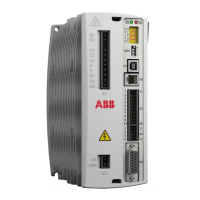158 Technical data
Control system
The MicroFlex e150 can use two main control configurations:
• Servo (Position).
• Torque Servo (Current).
The configuration is selected using the Mint CONFIG keyword (object 5000h), or by
using the Mint WorkBench System Configuration Wizard. Each configuration
supports different control modes, selected using the Tools, Control Mode menu item
or by using the CONTROLMODE keyword in the Command window (see the Mint help
file). This sets the control mode switch (object 6060h).
Servo configuration
The servo configuration is the default configuration for the drive, allowing the motor
control system to operate as a torque controller, a velocity controller or a position
controller. This configuration comprises 3 nested control loops; a current control loop,
a velocity control loop and a position control loop, as shown on page 159.
The universal encoder interface reads rotor position from the encoder and estimates
velocity. The commutation block uses the position to calculate the electrical angle of
the rotor. The current sensor system measures U and V phase currents. These are
fed into a current conversion block that converts them into quantities representing
torque producing and magnetizing currents (the 'vector' currents which are locked to
the rotor).
In the current control loop, a current demand and the final measured current values
form the inputs to a PI (Proportional, Integral) control system. This control system
generates a set of voltage demands that are fed into a PWM (pulse-width modulation)
block. The PWM block uses the space-vector modulation method to convert these
voltage demands into a sequence of U, V and W phase switching signals, which are
applied to the output bridge of the drive. The PWM block uses the measured DC-bus
voltage to compensate for variations in supply voltage.
The torque controller converts a torque demand into a current demand and
compensates for various load non-linearities. A 2-stage notch or low-pass filter allows
the effects of load compliance to be reduced. To avoid motor damage, a user-defined
application current limit is also applied, as well as individual positive and negative
torque limits.
In the velocity control loop, a velocity demand and measured velocity form the inputs
to a PI control system. The output of the control system is a torque demand which,
when the drive is operating as a velocity controller, forms the input to the current
control loop.
Finally, in the position control loop, a position demand and measured position form
the inputs to a PID (Proportional, Integral, Differential) control system incorporating
velocity feedback, velocity feed-forward and acceleration feed-forward. The output of
the position control system is a velocity demand which, when the drive is operating as
a position controller, forms the input to the velocity control loop.

